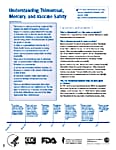Thimerosal and Vaccines
Thimerosal is a mercury-based preservative that has been used for decades in the United States in multi-dose vials (vials containing more than one dose) of medicines and vaccines. There is no evidence of harm caused by the low doses of thimerosal in vaccines, except for minor reactions like redness and swelling at the injection site. However, in July 1999, the Public Health Service agencies, the American Academy of Pediatrics, and vaccine manufacturers agreed that thimerosal should be reduced or eliminated in vaccines as a precautionary measure.
About Thimerosal
Mercury is a naturally occurring element found in the earth’s crust, air, soil, and water. Two types of mercury to which people may be exposed — methylmercury and ethylmercury — are very different.
Methylmercury is the type of mercury found in certain kinds of fish. At high exposure levels methylmercury can be toxic to people. In the United States, federal guidelines keep as much methylmercury as possible out of the environment and food, but over a lifetime, everyone is exposed to some methylmercury.
Thimerosal contains ethylmercury, which is cleared from the human body more quickly than methylmercury, and is therefore less likely to cause any harm.
Thimerosal prevents the growth of bacteria in vaccines.
Thimerosal is added to vials of vaccine that contain more than one dose (multi-dose vials) to prevent growth of germs, like bacteria and fungi. Introduction of bacteria and fungi has the potential to occur when a syringe needle enters a vial as a vaccine is being prepared for administration. Contamination by germs in a vaccine could cause severe local reactions, serious illness or death. In some vaccines, preservatives, including thimerosal, are added during the manufacturing process to prevent germ growth.
The human body eliminates thimerosal easily.
Thimerosal does not stay in the body a long time so it does not build up and reach harmful levels. When thimerosal enters the body, it breaks down to ethylmercury and thiosalicylate, which are readily eliminated.
Thimerosal has been shown to be safe when used in vaccines.
Thimerosal use in medical products has a record of being very safe. Data from many studies show no evidence of harm caused by the low doses of thimerosal in vaccines.
There are some side effects of thimerosal in vaccines.
The most common side-effects are minor reactions like redness and swelling at the injection site. Although rare, some people may be allergic to thimerosal.
Scientific research does not show a connection between thimerosal and autism.
Research does not show any link between thimerosal in vaccines and autism, a neurodevelopmental disorder. Many well conducted studies have concluded that thimerosal in vaccines does not contribute to the development of autism. Even after thimerosal was removed from almost all childhood vaccines, autism rates continued to increase, which is the opposite of what would be expected if thimerosal caused autism.
Thimerosal was taken out of childhood vaccines in the United States in 2001.
Measles, mumps, and rubella (MMR) vaccines do not and never did contain thimerosal. Varicella (chickenpox), inactivated polio (IPV), and pneumococcal conjugate vaccines have also never contained thimerosal.
Influenza (flu) vaccines are currently available in both thimerosal-containing (for multi-dose vaccine vials) and thimerosal-free versions.
For a complete list of vaccines and their thimerosal content level, see the U.S. Food and Drug Administration (FDA) Thimerosal in Vaccinesexternal icon page. This chart pdf icon[PDF – 4 pages] shows vaccine ingredients sorted by vaccine.
